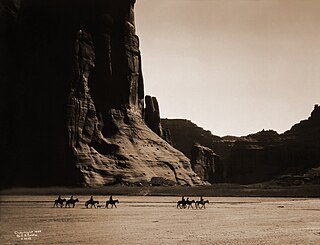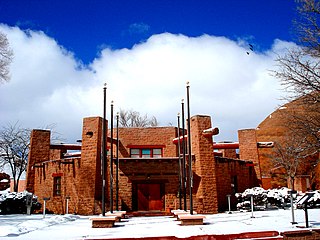
Archuleta County is a county located in the U.S. state of Colorado. As of the 2020 census, the population was 13,359. The county seat and the only incorporated municipality in the county is Pagosa Springs.

Cameron is a census-designated place (CDP) in Coconino County, Arizona, United States, on the Navajo Nation. The population was 885 at the 2010 census. Most of the town's economy is tourist food and craft stalls, restaurants, and other services for north–south traffic from Flagstaff and Page. There is a ranger station supplying information and hiking permits for the Navajo Nation as well as a small selection of books for sale. There is also a large craft store run by the Nation itself; most vendors in the area operate from small private stalls. It is named after Ralph H. Cameron, Arizona's first senator.

Manitou Springs is a home rule municipality located at the foot of Pikes Peak in western El Paso County, Colorado, United States. The town was founded for its natural mineral springs. The downtown area continues to be of interest to travelers, particularly in the summer, with many shops and restaurants, as well as a creekside city park. The main road through the center of town was one of the direct paths to the base of Pikes Peak. Barr Trail, which winds its way up Pikes Peak, is accessible from town. The subdivision Crystal Hills was added to the municipality in the 1960s.

Canyon de Chelly National Monument was established on April 1, 1931, as a unit of the National Park Service. Located in northeastern Arizona, it is within the boundaries of the Navajo Nation and lies in the Four Corners region. Reflecting one of the longest continuously inhabited landscapes of North America, it preserves ruins of the indigenous tribes that lived in the area, from the Ancestral Puebloans to the Navajo. The monument covers 83,840 acres and encompasses the floors and rims of the three major canyons: de Chelly, del Muerto, and Monument. These canyons were cut by streams with headwaters in the Chuska Mountains just to the east of the monument. None of the land is federally owned. Canyon de Chelly is one of the most visited national monuments in the United States.

Navajo Bridge is the name of twin steel spandrel arch bridges that cross the Colorado River in the Grand Canyon National Park in northern Coconino County, Arizona, United States. The newer of the two spans carries vehicular traffic on U.S. Route 89A (US 89A) over Marble Canyon between Bitter Springs and Jacob Lake, allowing travel into a remote Arizona Strip region north of the Colorado River including the North Rim of Grand Canyon National Park.

Hubbell Trading Post National Historic Site is a historic site on Highway 191, north of Chambers, with an exhibit center in Ganado, Arizona. It is considered a meeting ground of two cultures between the Navajo and the settlers who came to the area to trade.

The Colorado Springs Fine Arts Center at Colorado College (FAC) is an arts center located just north of downtown Colorado Springs, Colorado. Located on the same city block are the American Numismatic Association and part of the campus of Colorado College.

Old Colorado City, formerly Colorado City, was once a town, but it is now a neighborhood within the city of Colorado Springs, Colorado. Its commercial district was listed on the National Register of Historic Places in 1982. It was founded during the Pikes Peak Gold Rush of 1859 and was involved in the mining industry, both as a supply hub and as a gold ore processing center beginning in the 1890s. Residents of Colorado City worked at some of the 50 coal mines of the Colorado Springs area. It was briefly the capital of the Colorado Territory. For many years, Colorado Springs prohibited the use of alcohol within its border due to the lifestyle of Colorado City's opium dens, bordellos, and saloons. It is now a tourist area, with boutiques, art galleries, and restaurants.

The Wheelwright Museum of the American Indian is a museum devoted to Native American arts. It is located in Santa Fe, New Mexico and was founded in 1937 by Mary Cabot Wheelwright, who came from Boston, and Hastiin Klah, a Navajo singer and medicine man.

Briarhurst Manor, also known as William A. Bell House, is a finely grained pink Victorian sandstone manor house listed on the National Register of Historic Places in the city of Manitou Springs, Colorado. It is the second building on this site.

Navajo Nation Council Chamber is the center of government for the Navajo Nation. The landmark building, in Window Rock, Arizona, is significant for its association with the 1930s New Deal, and its change in Federal policy for relations with Native Americans, as established in the Indian Reorganization Act. With its red sandstone façade and overall rustic architectural style, the chamber was designed to harmonize with its spectacular natural surroundings. The building was declared a National Historic Landmark in 2004. It is "the only legislative headquarters in the United States owned by an American Indian tribe which has been continuously in use by that tribe and whose design incorporates indigenous materials and architectural traditions tied to the Navajo heritage."
Big Bead Mesa is a historic Navajo habitation site near Grants, New Mexico, within Cibola National Forest. Occupied from the mid-18th to early 19th century, the site gives an important window into the relations between the Navajo and the Puebloans of that time. First explored archaeologically in 1939, it was declared a National Historic Landmark in 1964.

This is a list of the National Register of Historic Places listings in Pitkin County, Colorado.

Manitou Springs Historic District in Manitou Springs, Colorado is roughly bounded by US 24, Ruxton Avenue, El Paso Boulevard and Iron Mountain Avenue. Listed in the National Register of Historic Places, it is one of the country's largest National Historic Districts.

Cliff House in Manitou Springs, Colorado is a Queen Anne style hotel in the Manitou Springs Historic District. It is a National Register of Historic Places listing. The Cliff House at Pikes Peak is a member of Historic Hotels of America, the official program of the National Trust for Historic Preservation.

Manitou Mineral Springs are natural mineral springs in Manitou Springs, Colorado and Cheyenne Spring House is on the National Register of Historic Places. The springs are located in one of the country's largest National Historic Districts.

Cragmor, first known as Cragmoor, is an area in northeastern Colorado Springs, Colorado, between Templeton Gap and Austin Bluffs. A coal mining site during the 19th century, the area became known as the Cragmor around the turn of the century because the Cragmor Sanitorium was located there. By the 1950s, the mines were abandoned and the land was developed for housing. Cragmor was annexed to the City of Colorado Springs in the early 1960s. The Cragmor Sanatorium became the main hall for the University of Colorado Colorado Springs campus.

The Tuba Trading Post, in Tuba City, Arizona, is a building complex which was started in 1891 by trader Charles H. Algert as a two-room shed built of native limestone. It is a mostly stone building made up of segments of different styles. It was listed on the National Register of Historic Places in 1996.

















